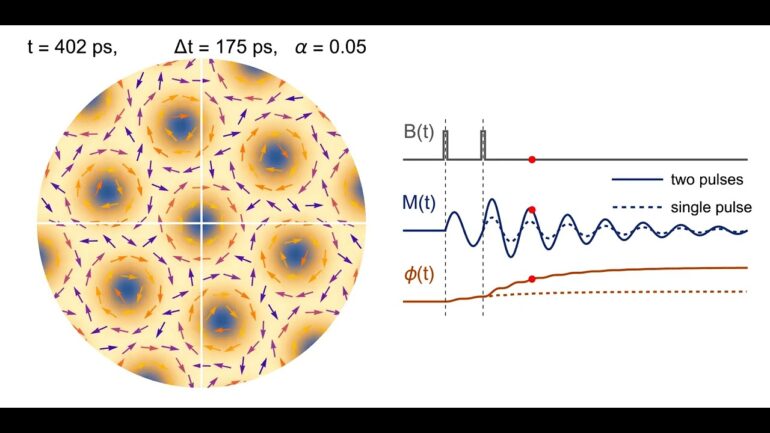Researchers at EPFL have developed a new technique that can visualize and control the rotation of a handful of spins arranged in a vortex-like texture at the fastest speed ever achieved. The breakthrough can advance “spintronics,” a technology that includes new types of computer memory, logic gates, and high-precision sensors.
“Technological advancements in computation, data storage and sensing all require new techniques to control the nanoscaled magnetic properties of materials,” says Professor Fabrizio Carbone at EPFL’s School of Basic Sciences. One of these properties is “spin,” which refers to the magnetic orientation of individual atoms.
Spin has attracted a lot of interest in recent years, giving rise to the field of spin electronics or “spintronics.” Apart from the fundamental study of spin, the more practical aim of spintronics is to exploit not just the charge of electrons—as in traditional electronics—but also their spin, adding and extra degree of freedom that can improve the efficiency of data storage and transfer.
However, this first requires that we can control small numbers of spins. “The visualization and deterministic control of very few spins has not yet been achieved at the ultrafast timescales,” says Dr. Phoebe Tengdin, a postdoc in Carbone’s lab, pointing out the very tight timeframes that this control needs to happen for spintronics to ever make the leap into applications.
Now, Tengdin along with Ph.D. student Benoit Truc and fellow postdoc Dr. Alexey Sapozhnik have developed a new technique that can visualize and control the rotation of a handful of spins arranged in a vortex-like texture, a kind of spin “nano-whirlpool” called a skyrmion.
To do this, the scientists used sequences of laser pulses at a femtosecond timeframe (10-15 or a quadrillionth of a second). By arranging the laser pulses apart just right, they were able to control the rotation of spins in a selenium-copper mineral known in the field by its chemical composition, Cu2OSeO3. The mineral is quite popular in the field of spintronics, as it provides an ideal testbed for studying spins.
Controlling the spins with laser pulses, the researchers found that they could even switch their orientation at will by simply changing the delay time between successive driving pulses and adjusting the laser polarization.
But the study didn’t stop there. By using using a type of transmission electron microscope that can “see” nanoscale dimensions, the team were also able to actually image the spin changes. The breakthrough has enormous implications for the fundamental aspects of spintronics.
The research is published in the journal Physical Review X.
The work offers the field a new protocol for controlling magnetic textures at ultrafast timescales, and opens up exciting new opportunities for spin switches in next-generation information storage devices.
“Our experiments demonstrate that it is possible to manipulate and image a handful of spins at very high speed using a moderate intensity light beam,” says Tengdin. “Such an effect can be exploited in low-consumption ultrafast devices operating on spins. New types of memories or logic gates are possible candidates, as are high-precision sensors.”
More information:
Phoebe Tengdin et al, Imaging the Ultrafast Coherent Control of a Skyrmion Crystal, Physical Review X (2022). DOI: 10.1103/PhysRevX.12.041030
Provided by
Ecole Polytechnique Federale de Lausanne
Citation:
Ultrafast control of spins in a microscope (2023, January 27)



